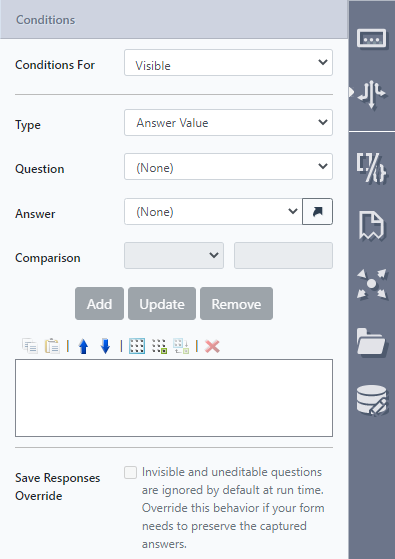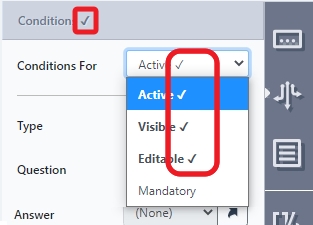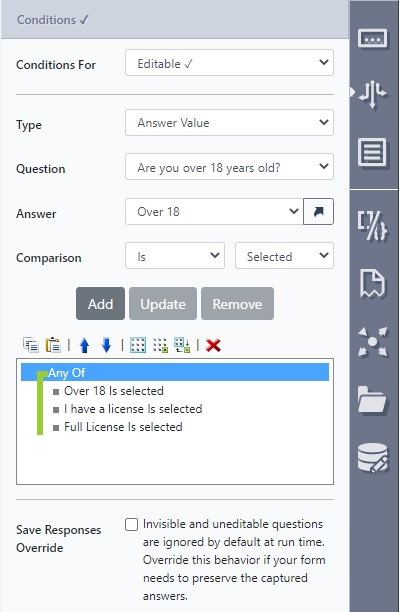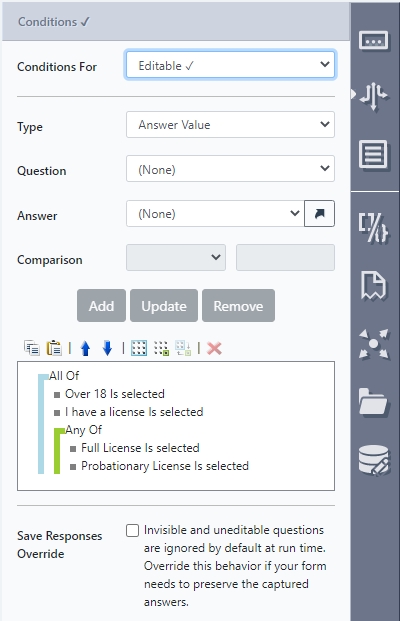Conditions
Overview
Conditions change the questions and content displayed within a form as well as its editability based on defaults and responses provided by the user, ensuring the most efficient and correct path through the form. Conditions are also responsible for which workflow transitions to choose and what actions to run after a form is completed.
Conditions use clauses that, when rendered to true or false, cause an outcome. For example:
- The Postal Address section becomes editable after indicating that the postal address is different from the address.
- Additional questions became visible after selecting Yes to being over 18 years old.
- The License type question became Mandatory after saying Yes to having a license.

Condition Types
There are several condition types, each described in detail within this section. Individual form elements can have multiple condition types applied. For example, make a question visible when 'x' but mandatory only when 'y'.
Condition types are available depending on what they are being applied to, the table below outlines exactly what condition type applies to what.
Items | Active | Visible | Editable | Mandatory | Adding or removing sections |
|---|---|---|---|---|---|
Questions | Yes | Yes | Yes | Yes | |
| Yes | Yes | Yes | ||
| Yes | ||||
Repeating pages/sections | Yes | Yes | Yes | Yes |
Active
Active conditions control if an item is at all relevant. When something is inactive, it is completely ignored. If an item becomes inactive half way through a form or workflow process, any data collected so far is disposed and any additional conditions, visible, editable, mandatory etc. no longer apply. Ultimately, an item that is made inactive renders the item irrelevant to the final outcome.
This is the only condition that can be used for all content within a form.
Visible
Visible conditions determine whether the item will be visible to the user in the wizard.
A non-visible item is hidden but still active and thus will retain any data collected thus far in the process. Visible conditions are often used in workflow where content is only shown to particular users or groups depending on which state of the workflow you are up to.
For example, a linear or parallel workflow might need different responses from HR and Finance teams. Different groups of questions would be made visible to the HR and/or Finance teams respectively.
Editable
Editable conditions, while allowing the user to see a question within a form, prevents changes to the questions value, effectively making it read only. Editable conditions are useful for workflow scenarios where the current user can see the responses provided by previous users but cannot make changes.
Mandatory
Mandatory conditions provide the option to make a question mandatory based on the user response. For example, an email address might be made mandatory if the preferred contact method is email.
NoteThe Mandatory condition type is only available for questions.
Adding or Removing Sections
Provides the option to make a section or page repeating based on the user response. For example, a previous work experience section can be a repeating section and the user can add more experience as needed.
NoteThe Adding or Removing Sections condition type is only available for Repeating Pages/Sections.
Defining Conditions
- In Design, open a project and click the item within the form to make conditional. Use the Conditions icon to show the Conditions panel.

-
Select a condition type from the Conditions For: drop-down list.
-
Select the clause type from the Type drop-down list and specify the following:
- Question AND Answer or;
- Action AND Output or;
- Fragment AND Output.
-
Select the Comparison operators from the two drop-down boxes and click the Add button.
-
Use the ‘Any Of’ and/or ‘All Of’ groups for Grouped Conditions.
-
Add more conditions as necessary.
-
(Optional) For Visible and Editable conditions, enable the Save Responses Override option.
-
Repeat the steps until all the conditions have been added.
A checkmark will appear to indicate that a condition has been applied to any of the conditions.

Grouping Conditions
Use the ‘Any Of’ and/or ‘All Of’ groups for conditions that combine multiple clauses.
- ‘Any of’ groups only need one condition to be met.
- ‘All of’ means all conditions within the group have to be met in any order.

Condition groups can also be nested to support complex paths and decision making.
SmartIQ will process conditions sequentially, starting with the top and will only proceed to the next condition if the previous condition has been satisfied.
NoteEnsure that multiple condition types do not conflict or contradict with one another when adding nested conditions, especially with Active conditions. Always test the forms before adding to a live page.

Add, remove and reorder clauses using the buttons above the displayed clauses:
- Convert group type between ‘All Of’ to ‘Any Of’ or vice versa by selecting the group and clicking the Convert button.
- Change order of priority by selecting the condition and then clicking the Up and Down arrows to move the condition up or down.
- Copy from another condition group and/or Replace the current conditions.
- Remove any condition.
Save Responses Override
Editable and Visible conditions have a Save Responses Override option where the question will always be processed. This is because, for efficiency in most scenarios, SmartIQ will skip non-editable/non-visible questions when processing as users cannot interact with them during a form. In rarer scenarios, particularly where the question changes their editable/visible during a form, the skip can result in data loss between workflow states. In these scenarios the save responses override can be applied.

Updated 8 months ago
